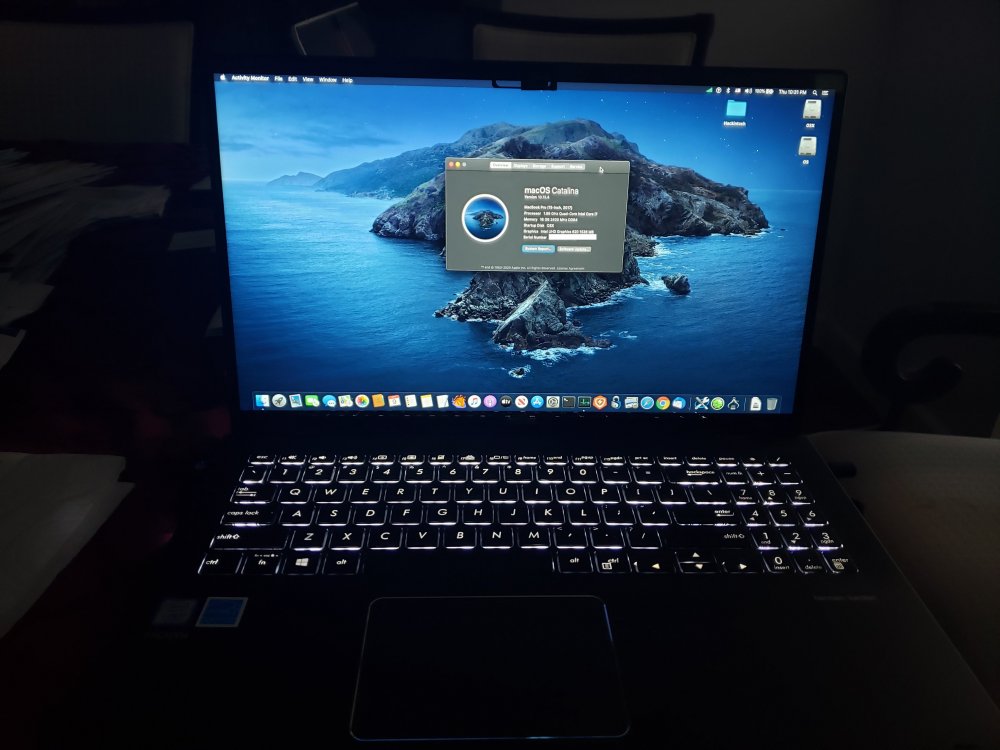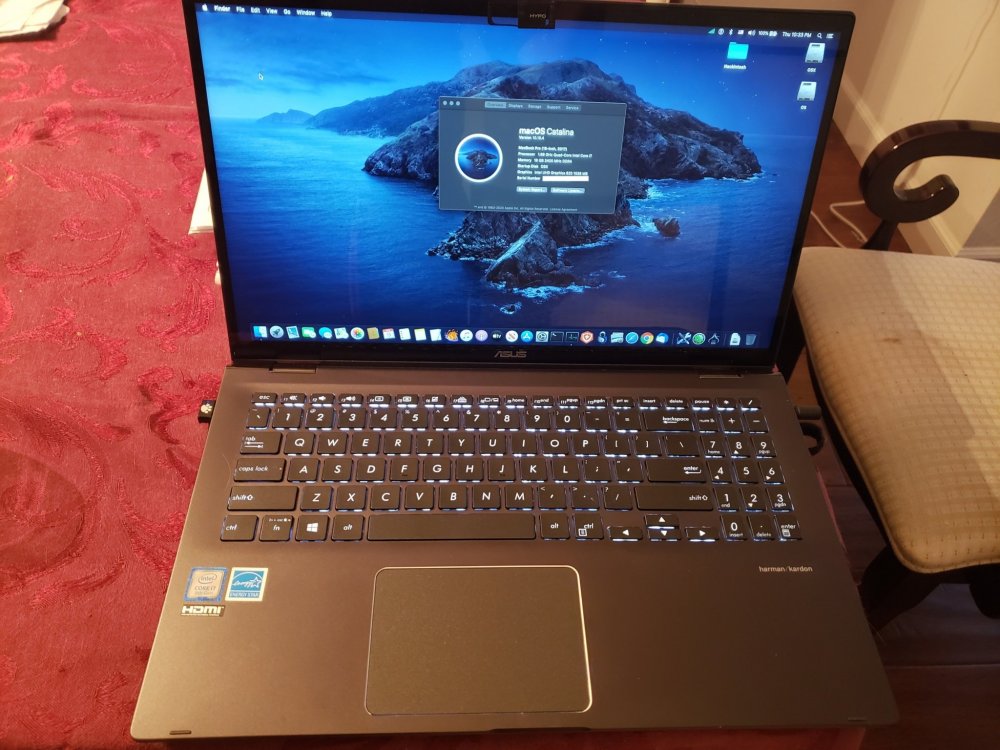Laptop: ASUS Zenbook Q526FA-BI7T10
CPU: i7-8565U @ 1.8GHz
GPU: HDU 620
RAM: 16GB
Drives: 128GB SSD, 1TB HDD
DISCLAIMER:
This was my first hackintosh, so I am still in the process of learning how to do this better. I am certain that this is not the most efficient path to getting this laptop to work. I have probably used some redundant and unnecessary settings, patches, and files, but I got it working pretty well and I am not trying to perfect the process of creating a hackintosh (not on this one at least).
During the install, I tried to track every change and experiment, but the changes were incremental, so the configurations described below are what got me fully through the install process.
Also, when I was near the end of the install, I initially mistook the reboots as a problem and did not realize at the time that it was just a part of a successful install. I made a change to the Clover boot args (removed cpus=1) after I got to the point where the MacOS install dialogs were successfully coming up and that got me past the final stages of the install.
During the post install, I did not track my changes and experiments as well as I did on the install, but I believe I have captured all of the essentials in this post.
Install Files
I have provided the ACPI, drivers, kext, and config.plist files of 3 Clover EFIs:
(1) My initial one that got me to the install dialog where I could format the destination drive and continue with the install.
(2) The one I used to get from the install dialog to the installed MacOS.
(3) The final version I currently use with the trackpad and other features working.
It is entirely possible that the 3rd configuration will work for the whole process.
On a Mac system (I used my 2017 MacBook Pro)
- Enter MacOS recovery and disable System Integrity Protection:
csrutil disable
- With a 16GB+ flash drive, create an MBR FAT32 partition and an HFS+J partition in a terminal as follows:
diskutil partitionDisk /dev/disk# 2 MBR FAT32 "CLOVER EFI" 200Mi HFS+J "install_osx" R
Note: disk# is the flash drive disk as listed by “diskutil list”
- Install Clover in the CLOVER EFI partition. I used Clover version 5102.
- Install the Catalina install on the install_osx partition:
sudo "/Applications/Install macOS Catalina.app/Contents/Resources/createinstallmedia" --volume /Volumes/install_osx --nointeraction
- Replace config.plist in Clover with RehabMan’s config.plist for HD 620, … (config_HD615_620_630_640_650.plist). Make sure it is named “config.plist”…
- Put the following kexts in EFI/CLOVER/kexts/Other/ (to be certain you are using the latest versions do not use any that came with Clover):
Lilu.kext
FakeSMC.kext
USBInjectAll.kext
VoodooPS2Controller.kext (from RehabMan)
VoodooTSCSync.kext (Use VoodooTSCSync Configurator to configure for 4 cores)
WhateverGreen.kext
- Put the following kexts in EFI/CLOVER/ACPI/patched:
SSDT-USBX.aml
SSDT-EC.aml
- Put the following drivers in EFI/CLOVER/drovers/UEFI:
ApfsDriverLoader.efi
AptioInputFix.efi
DataHubDxe.efi
FSInject.efi
HFSPlus.efi
OsxAptioFixDrv-64.efi
SMCHelper.efi
- Using Clover Configurator, do the following on config.plist:
Acpi:
Apply an ACPI Patch:
Find: A00A9353 54415301
Replace: A00A910A FF0BFFFF
Select FixIntelGfx
Boot Args:
Dart=0
nv_disable=1
-cdfon
lilucpu=8
cpus=1 (Note: Herve suggested that I use the Kernel LAPIC patch -- I will definitely look into that for my future hackintosh projects!)
-v
Devices:
Delete Arbitrary entries
Delete Added Properties entries
Set IntelGfx Fake ID: 59178086
Graphics:
Set ig-platform-id: 59178086
Select Inject Intel
SMBIOS:
Product Model: MacBookPro14,3
On the ASUS
Go to the BIOS setup and do the following:
- Disable Fast Boot in BIOS
- Disable Secure Boot in BIOS
- Plug in a USB Mouse
- Hold Esc while starting ASUS and choose USB for boot
- In Clover: Boot from install_osx
- Use diskutil to reformat the DATA disk as APFS and name the disk OSX.
- Install MacOS to OSX as follows (this is tricky!):
I am certain I did NOT do this efficiently, but this is what I did to complete the install:
- Per my instructions above, you started with the cpus=1 boot arg. You may need to delete the cpus=1 boot arg if you have reached the MacOS install dialogs, but are not successfully getting through the install process.
- When the ASUS reboots during the install, keep retrying until you see an OSX boot drive choice in Clover.
- When you see the OSX boot drive choice in Clover, continue the install from the OSX boot drive.
- If the install does not complete, then I found that choosing the install_osx boot drive and going through a few extra install steps before booting from OSX did not cause any regression in the progress.
After the install, go through the MacOS set up dialogs like you would on any Mac system.
Post Install
The post install is complex. I will just explain what I generally did and the various files I used. I have provided my current Clover EFI.
Use Clover Configurator to mount the EFI partition from OSX drive.
Merge the EFI from your flash boot drive into the OSX EFI folder.
I used Hackintool I labeled all of the USB ports as "internal" and exported USBPorts.kext, SSDT-UIAC.aml, and SSDT-USBX.aml
Although it has been advised that I should label all of the USB ports as "internal", all of the USB ports have been functioning fine
and it has been the only way I could get sleep working properly. I will try other things later, if I experience any USB issues.
Using MacIASL, iasl, and patchmatic, I did several patches on the DSDT:
[Windows] Windows 10 Patch
[kbl] WhiskeyLake
GPIO pinning for the trackpad (device ETPD, GPIO pin # x6D) and touchscreen (device TPL0, GPIO pin # x72).
Configure Clover as follows:
EFI/CLOVER/ACPI/patched:
DSDT.aml
SSDT-EC.aml
SSDT-GPIO.aml
SSDT-PNLFCFL.aml
SSDT-UIAC.aml
SSDT-USBX.aml
SSDT-XOSI.aml
EFI/CLOVER/kexts/Other/:
AppleALC.kext
AsusSMC.kext
Lilu.kext
SMCBatteryManager.kext
SMCLightSensor.kext
SMCProcessor.kext
SMCSuperIO.kext
USBPorts.kext
VirtualSMC.kext
VoodooI2C.kext
VoodooI2CHID.kext
VoodooPS2Controller.kext
VoodooTSCSync.kext
WhateverGreen.kext
EFI/CLOVER/drovers/UEFI:
ApfsDriverLoader.efi
AptioInputFix.efi
DataHubDxe.efi
FSInject.efi
HFSPlus.efi
OsxAptioFixDrv-64.efi
Using Clover Configurator, make these changes to the config.plist used for the install:
Acpi:
Keep/Apply this ACPI Patch (it should already be in the install config.plist):
Find: A00A9353 54415301
Replace: A00A910A FF0BFFFF
(credit RehabMan)
Enable the following patches:
change OSID to XSID (to avoid match against _OSI XOSI patch)
change _OSI to XOSI
Select Generate PStates
Select Generate CStates
Boot Args:
Dart=0
nv_disable=1
-cdfon
lilucpu=8
alcid=21
igfxcflbklt=1
Devices:
Set IntelGfx Fake ID: 0x0
In Properties:
Device: PciRoot(0)/Pci(0x02,0)
AAPL,ig-platform-id 0900A53E DATA
device-id A53E0000 DATA
Graphics:
Set ig-platform-id: 0x0
Unselect Inject Intel
Kernel and Kext Patches:
Name: com.apple.driver.AppleIntelLpssI2C
Find [Hex]: 494F4B69 74
Replace [Hex]: 494F4B69 73
Name: com.apple.driver.AppleIntelLpssI2CController
Find [Hex]: 494F4B69 74
Replace [Hex]: 494F4B69 73
Note: The last two patches prevents Apple I2C kexts from attaching to I2C controllers, credit CoolStar
Configure VoodooI2C for the touchpad (FTE 1200):
SSDT-XOS.aml
SSDT-GPIO.aml
Device ETPD, GPIO pin #: x6D
Configure VoodooI2C for the touchscreen (ELAN 9008):
Device TPL0, GPIO pin #: x72
Note: Gestures and cursor follow work. “Click” does not work.
This “guide” is not perfect, but I hope it helps!
I am going to start on a Dell Latitude E7270 i7-6600U in about a week.
Cheers!
CLOVER post install.zip CLOVER for completing install from OSX.zip CLOVER for Initial Install.zip




